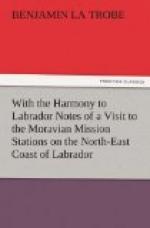One of the Hopedale paths leads “to the heathen,” and what more interesting spot could we visit than those three mounds, which are all that remain of the former winter dwellings of the original heathen population. One by one, and sometimes several at once, when the Spirit of the Lord was powerfully bringing home to their hearts the Gospel preached by the early missionaries, the inmates of these abodes moved from their pagan surroundings and began to make themselves Christian homes around the mission-houses.
On our way to the long uninhabited ruins of this older group of abodes, we will pass through the Christian village, which has thus sprung up at Hopedale as at all the other stations. It consists of irregular groups of little log houses, planted with little attempt at symmetry. Their Eskimo owners have no idea of a street. Perhaps some day the conception may occur to them as they read in their Bibles of “the street which was called straight.” Nor do they need any words in their language for “rent,” “rates,” or, “taxes.” Here in the south and at the station most influenced by civilization, the majority of the little houses are built of logs and even roofed with wood. Some are covered with turf. The dwellings of our people in the north are much more primitive. Each house has its low porch, a very necessary addition in this land of “winter’s frost and snowing.”
Between the houses and in their porches lie many dogs. One of these wolf-like creatures follows us over the rocks to the burial-ground, and then runs off to fish on his own account. The dogs scour the shore for miles in search of food, for, with the exception of those belonging to our stores, they mostly have to forage for themselves. They like seal and reindeer meat, but there are times when they can get neither flesh nor fish. Then they turn vegetarians, spring over the fences of the mission gardens and help themselves.
We enter the irregular enclosure, where lie the bodies of many, who have fallen asleep during the hundred years that Hopedale has stood. Here are some Eskimo graves with little headstones, bearing brief inscriptions, but more mounds without identification. In one corner lies a group of graves of touching interest—the missionaries and their children—who have taken sepulchre possession here.
Thence our way lies along the shore. What is that noise? It is a whale blowing in the smooth water. Look, yonder rises the column of spray, and now a great fin appears for a moment over the surface. Wait awhile, and the monster will blow again. Yes, there he is, spouting and diving; on the whole, we can hear more than we can see of him.




